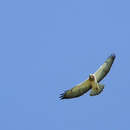en
names in breadcrumbs


Perception Channels: visual ; tactile ; acoustic ; chemical
This species of hawk is on the list of Federal Species of Concern, and is also considered threatened by the state of California. The primary cause of this concern is the massive killing of more than 20,000 Swainson's Hawks by pesticides used in the Argentina agricultural areas. In order to help these hawks recover, the use of deadly pesticides by Argentinian farmers must be stopped. Although the farmers are in support of saving the birds, this recovery effort is proving to be a daunting task (Brown 1996, Line 1996).
US Migratory Bird Act: protected
US Federal List: no special status
CITES: appendix ii
State of Michigan List: no special status
IUCN Red List of Threatened Species: least concern
The Swainson's Hawk is of special importance to farmers, both in North and South America. Some Swainson's Hawks will live entirely on insects and rodents that it catches in crop fields, thus alleviating some crop destruction for farmers. This species is also important to scientists as they can study the ecological details of its massive migration of over 5,000 miles (Brown 1996, AID 1997, Line 1996).
The Swainson's Hawk is somewhat of a generalist, and eats whatever it can find. During its time in North America, its diet consists of insects, small mammals and birds, and occasional reptiles and amphibians. When these birds migrate to the Argentina area, they feed mainly on insects like grasshoppers and crickets (Brown 1996, TPWD 1997).
The Swainson's Hawk, -Buteo swainsoni-, spends most of the year in the western United States extending into southwest Canada and south to west Texas. In the winter months, these birds migrate over Central America to the La Pampas region of Argentina (Brown 1996, TPWD 1997).
Biogeographic Regions: nearctic (Native ); neotropical (Native )
This hawk prefers open grasslands and desert-like habitats. It is common to see this hawk perched on a fence post in a prairie or open range. The Swainson's Hawk also inhabits agricultural areas, and is known to follow farmer's tractors in search of insect or rodent prey (Brown 1996, AID 1997).
Terrestrial Biomes: desert or dune ; savanna or grassland ; chaparral
Range lifespan
Status: wild: 19.5 (high) years.
Average lifespan
Status: wild: 235 months.
This hawk's most unique feature is its variation in color. The light color morph includes white patches on the forehead, the throat and the belly. The rest of the body is a dark brown. The dark color morph, which is the less common type, includes an entirely dark brown body with only a white patch under the tail. Other variations between these two distinct extremes have been observed. These hawks vary in length from 19 to 22 inches, and have a wingspan of 47 to 57 inches. An average weight for a male is 1.8 pounds, while the average for the female is almost 2.5 pounds. This bird is commonly confused with a Red-tailed hawk, but the Swainson's Hawk has a longer wingspan, more variation in color, and flies in a slight dihedral pattern (Brown 1996, AID 1997).
Other Physical Features: endothermic ; bilateral symmetry
Average mass: 980.64 g.
The Swainson's Hawk starts the breeding season by building nests in March and April. The nest are usually found in trees, shrubs, on the ground, or on top of utility poles. These hawks are mostly mongamous, so a breeding pair may return to a previous nesting site. These birds become highly territorial towards their nest and their mate during this time of the year. When the nest is complete, the female lays 2 to 4 whitish-colored eggs with brown flecks. The male usually helps the female with the incubation, which lasts for about 30 days. The young hatch between March and July, and stay in the nest for another 30 days. While most juveniles migrate the following winter with their parents, there are some groups that do not migrate their first winter (Brown 1996, TPWD 1997).
Key Reproductive Features: iteroparous ; gonochoric/gonochoristic/dioecious (sexes separate); sexual ; oviparous
Average time to hatching: 31 days.
Average eggs per season: 3.
Average age at sexual or reproductive maturity (male)
Sex: male: 730 days.
Average age at sexual or reproductive maturity (female)
Sex: female: 730 days.